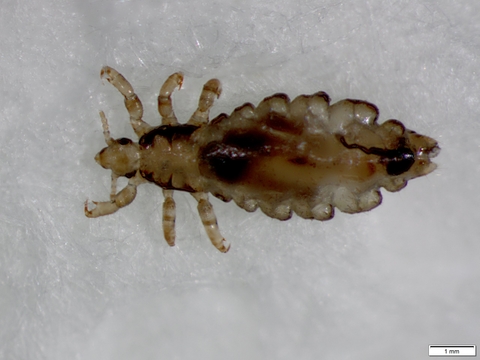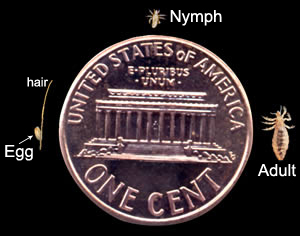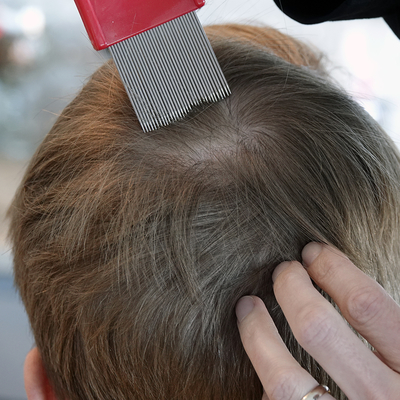Quick facts
- Head lice, Pediculus humanus capitis, are a common problem, especially on children.
- They do not carry diseases but their biting can cause considerable itching.
- People get head lice only from other infested people.
- To help prevent the spread of head lice, do not share combs, brushes, scarves, clothing, hats, towels or similar items.
- Physical removal can help control head lice.
- You can buy special shampoos to treat head lice, either over-the-counter or by prescription from a doctor.
Why are head lice important?
Who is at risk?
- Head lice are most commonly a problem for children, but adults can get head lice.
- Head lice can spread quickly between children because they do things that help lice spread—such as sharing hats or combs.
- Lice only infect humans, so pets are not at risk of catching head lice.
- Head lice only infest the head area, other types of lice are associated with other locations on the human body.
What do head lice do?
- Head lice spend their whole lives on our head where the adults and nymphs feed on blood.
- The bites are painless and cannot be felt at all, but our bodies can react to the saliva injected when they bite. For most people this causes intense itching, like the itch of mosquito bites.
- Head lice feed multiple times a day so there are many bites that itch.
- Head lice do not carry any diseases and are not known to spread any diseases between humans.
- Having head lice can be a source of embarrassment and it takes time to get rid of them.
- Children with head lice may have to miss school depending on the school district's policy about lice.
How to identify head lice
Correct identification of head lice is very important as other insects or even debris, like bits of skin or scabs, may be confused for head lice.
Adult head lice
- Small, about 1/8-inch-long (about the size of a sesame seed).
- Grayish, flattened bodies; wingless.
- They have claw-like legs to more easily hold onto hair.
Immature head lice (nymphs)
- Look the same as adults but are smaller.
Nits (lice eggs)
- Whitish, oval and the size of a pinhead (1/30 inch long).
- They are firmly attached to the hair shaft near the scalp.
- Nits do not move, but as hair grows they move out from the scalp.
- Nits found further than 1/2 inch from the scalp nearly always have hatched or died.
- Nits are the easiest life-stage to search for in order to confirm head lice infestation.
- Head lice spend their entire lives on the heads of humans, especially young children.
- They need our blood and body heat to survive.
- A head louse can only live off a human for about a day.
- Head lice cannot survive on the blood of other animals and will not infest dogs, cats or other pets.
- Head lice can move from an infested person to another person during play or other close contact.
- Lice can also spread when an infested person shares combs, brushes, scarves, clothing, hats, towels or similar items.
- Head lice do not jump or fly.
Anyone can have head lice
- It doesn't matter how clean a person or their home is.
- People get head lice only from other infested people.
- Head lice do not infest homes; they are not found in furniture, carpet, rugs or other places.
- They cannot survive off a human host for more than 24 hours before they die.
Life cycle
- Adult females attach eggs to individual hairs close (within 1/4 inch) to the scalp, especially behind the ears and on the nape of the neck.
- They can lay as many as 10 eggs in one day.
- Eggs hatch in 5 to 10 days.
- Young head lice (called nymphs) feed daily on blood and develop into adults in about 9 to 12 days.
- Adults live for about 30 days.
How to tell if you have head lice
The most common symptom is itching. It typically starts about 4 to 6 weeks after the first bite. However, not everyone is allergic to bites and infestations can go unnoticed for a while.
Itching can alert you that head lice may be a problem. To verify a head lice infestation, it is necessary to find live lice on the hair or scalp of a person.
The presence of nits also confirms a head lice problem. Look especially at the nape of the neck and behind the ears. If the nits are more than 1/4 inch from the scalp, they likely have either hatched or are dead.
Don’t confuse head lice or nits with dandruff, scabs or other debris. Be sure head lice are confirmed before treating a person.
How to control head lice
Head lice move from person to person through close contact. Head lice do not survive off a person any longer than one or two days. Any head lice that drop to the floor are not very likely to survive.
To help prevent the spread of head lice:
- Avoid sharing items like combs, brushes, headbands, hair ties, towels and similar items that come in contact with the head.
- Combs and brushes that have been used by an infested person can be disinfected by soaking the items in hot water (at least 130o F) for 5 to 10 minutes.
- Children should avoid sharing clothes, such as hats, caps, scarfs and coats.
- Children should also avoid head-to-head contact when playing or other activities at home, school or other places.
- Clothing or bed sheets and pillow cases and other items that may have been exposed to head lice can be exposed to hot or cold temperatures to kill the head lice (see Non-chemical below).
Physical removal
- Physical removal of head lice is time consuming and can be combined with chemical treatments.
- Physical removal focuses on the removal of the nits attached to the hair shaft and is best done with a specialized nit comb and on wet hair.
- All observed nits should be completely removed every 2 or 3 days and each nit removal session can take an hour or more.
Heat or cold
- Do NOT use heat or cold to kill lice on humans.
- Hair dryers and styling bonnets will not control head lice.
- Clothing and bedding of an infected person can be laundered on the hottest setting and dried with high heat to kill any lice.
- Items that cannot get wet can be placed in the dryer at high heat.
- Combs and brushes can be soaked in hot water (130F) for 5 to 10 minutes.
Suffocation (not effective)
- Trying to kill lice by smothering them is not effective.
- Common items placed in hair to smother lice are mayonnaise, olive oil, butter, or petroleum jelly.
- Clinical studies have not found evidence of them working and reports of effectiveness may be because removal of the products from hair requires multiple washings and combing.
General precautions
- Apply shampoos and lotions exactly according to directions.
- Do not apply conditioner or shampoo/conditioner combo before using lice medication.
- Do not wash treated hair for one to two days.
- Do not over apply products.
- Do not apply extra amounts.
- Do not use them more frequently than indicated by directions.
- Do not apply same product more than 2 or 3 times.
Over-the-counter products
- Contain either permethrin (Nix) or pyrethrins (Rid).
- It may be necessary to make a second treatment 9 days later to kill any new lice that have emerged from eggs.
Prescription products
A doctor can prescribe an insecticide containing shampoo that is not available over-the-counter. These shampoos will have very specific instructions and limitations on use. Be sure to follow your doctor’s recommendations and the instructions provided with the prescription shampoos.
Products that a doctor can prescribe are:
- Ovide (malathion) lotion
- Ulesfia (Benzyl alcohol) lotion
- Natroba (spinsosad) 0.9% topical suspension
- Sklie (ivermectin) lotion
Lindane can also be used to treat head lice. However, this product should be considered only as a last resort. It is more toxic than other products and people should not apply it.
Apparent treatment failure
There are several reasons why a treatment may appear to not be successful:
- The problem is misdiagnosed originally.
- A product has not been used properly.
- A person becomes reinfested.
- The nits that are found are dead or empty.
- There is pesticide resistance:
- Resistance is when a pesticide no longer kills head lice.
- Resistance can be a problem with products containing permethrins (Nix) or pyrethrins (Rid).
These treatments are not effective at controlling head lice:
- Vegetable oil, mayonnaise, or similar material
- Garlic (as paste)
- Salt (mixed with vinegar)
- Treating home with insecticides
- Hairdryers
For more information, see the Centers for Disease Control and Prevention (CDC).
Reviewed in 2020





